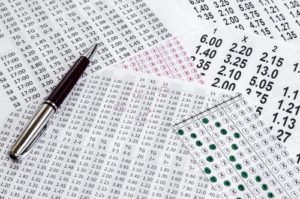

This is a collection of our strategy guides for both live betting and sports betting in general. This page alone has 2,500+ words of information. In addition, we have several other articles explaining different strategy concepts. After reading all of this, you should be well on your way to becoming a winning in-play bettor (and a winning sports bettor in general).
Sportsbooks offer different types of bets, some of which or many of which you may not immediately understand. We’re going to examine the three most common types of basic bets: the point spread, moneyline and over/under.
Let’s consider how each of these types of bets work (we’ve also written separate guides for each of these bet types):
The point spread is perhaps the best known of any and all wagers. Also known as “the spread,” this wager pays 1.00:1.10. That means that you get back your original bet of $1.10 plus $1.00 if you win. Although many will claim that point spreads pay even odds, that is 1:1, this is not the case.
That’s because with every point spread wager you must pay a commission (also known as vigorish, vig or juice). This is usually 10% of the wager. When you place a $10 spread bet, you actually pay $11 with the extra buck being the commission. If you win, you get back $11 plus $10 more for a total of $21. If it were a true even wager, you’d get back $11 and $11 more for a total of $22.
The term “point spread” refers to the fact that in each game for betting purposes the playing field is made even by giving points to the underdog and taking them away from the favorite. A typical point spread bet would look like this.
Bets are listed with the visitors first and the home team second. In our example, the visiting Patriots are favored by seven-and-a-half points. That means if you put your cash on New England they must win the game by at least eight points to payoff.
The Browns, who are the home team, are given points because they’re the underdog. If you wager on the Browns and they win outright or lose by less than eight points, you win.
With the point spread, bookies attempt to even out the odds in terms of who can win. This way, they also attempt to spread the sports betting between both teams.
Of the three different types of bets, the traditional moneyline wager may be the most straightforward. That’s because whichever team wins the game outright is the one that pays off. Bookies are usually able to set their moneyline odds in a way that allows them to receive bets for both sides evenly:
A moneyline will look like this:
In this scenario, the Patriots are once again the favored club. The team that’s considered to be the most likely to win is listed in the negative. Listing the Pats at minus-150 means that in order to win $100, you must bet $150. If you do win, you’ll get back your original wager of $150 plus $100.
The Browns are not favored, which means that their moneyline has a plus in it. For a team listed with a plus, the unit bet is $100. Thus, if you wager $100 on Cleveland and the Browns win, you’ll get your original wager back plus $160.
With the moneyline, whichever team wins outright pays off. The way that handicappers even out the betting is by making it more lucrative to wager on the underdog, since they payoff at a much higher rate than the favored club.
Of the three different types of bets that are considered to be standard in the realm of sports betting, the over/under is the only one that is not based on one of the teams winning. It does, however, have two characteristics in common with the point spread and moneyline.
It is a single wager and it is based on the overall outcome of the game. The over/under is a bet that is placed on the total amount of points scored. Each game has a point total listed and you put money down on whether the total number of points will be over or under that amount.
The over/under would look like this:
In our example, if you bet the under and the total points scored equal 35 or less, you would win your bet. Likewise, if you wager on the over and more than 35 points are scored, your wager would be a winner. These bets usually pay the same as point spread wagers (1.00:1.10).
It’s important to realize that as it is with the two other different types of bets, the over/under is determined after analyzing recent past performances of both teams, each club’s personnel, matchups and relative statistics.
Handicappers don’t pull these (or any of the other) numbers out of thin air. The odds and choices are dictated by a great deal of analysis.
There are many other different types of bets that are available through sportsbooks. In another article the various “exotics” will be examined. In sports betting strategy, the term exotics refers to any wager that is not a single-game wager or is not based on the outcome of a game. These types of bets are much harder to hit than the three basic sports bets discussed in this article.

The Gambler’s Fallacy is a belief that all outcomes even out and it is best illustrated by the flip of a coin. It’s commonly thought that if you flip a coin a certain number of times that it will come up heads and tails an even number of times. In other words, if I flip a coin 100 times, it will come up heads 50 times and tails 50 times.
In our scenario, let’s say we flip the coin 40 times and it comes up tails 30 and heads 10. According to the Gambler’s Fallacy, at some point the number of heads will catch up to the number of tails. But this is not necessarily true.
The fact is that each flip of the coin is an action unto itself and the outcome of one toss is independent of all others. There is no reason that the number of heads and number of tails should even out. It is true that each time you flip the coin there’s a 50-50 chance that it will come up either heads or tails but that does not mean that the result will be that heads and tails occur an equal number of times. It simply means that the odds are even concerning which side of the coin is exposed after it’s tossed.
We can apply this same concept to sports betting. Each game you bet is like each toss of the coin. There’s one of two possible outcomes and the result of the first game you wager on has no effect on the result of the second and so forth.
Those who wager on sports often believe that a series of loses will be followed by a series of wins. This isn’t true. A series of losses may be followed by one or two or a series of wins or even more loses. The results of your wagers have nothing to do with the law of averages or with wins and loses equaling out. If it did, then no one would ever make or lose money at sports betting. Everyone would simply break even and we know that just doesn’t happen. Some people win more than they lose and others lose more than they win and some just break even.
As your wins and loses add up, you’ll need to make continuous adjustments as you refine your handicapping skills and use various tools to pick winners consistently. Don’t rely on fate, magic or a good luck charm to turn the tide if you’re losing. Reevaluate how you’re making your picks in an objective fashion in order to get on the right track. Do not rely on the Gambler’s Fallacy to save you.
 It’s usually a good idea to be fairly conservative with your live betting strategy. You’re faced with so many choices that you can easily stress out your bank account and nerves by placing too many bets at one time.
It’s usually a good idea to be fairly conservative with your live betting strategy. You’re faced with so many choices that you can easily stress out your bank account and nerves by placing too many bets at one time.
Still, part of the excitement and fun of live sports betting is the fact that you can wager in numerous ways on an event as it’s happening.
So, when should you go for it, placing 2-5 different bets at once?
Needless to say, you should be ahead prior to expanding your wagering. That means you need to have doubled your stake for the game on which you’re presently betting. If you started out with $100 at $10 a unit, you should now have $200 at $10 a unit. That means you’ve gone from having 10 units to 20. You’re going to use some of those extra 10 units to expand your number of bets.
Here’s a recommendation for the number of units you should use based on how much you’ve won. Again, you started out with $100.
| Bank and Winnings | Profit (Units) | Total Units | Units for Next Wager |
| $200 | $100 (10) | 20 | 2 units |
| $250 | $150 (15) | 25 | 3 units |
| $300 | $200 (20) | 30 | 4 units |
| $400 | $300 (30) | 40 | 5 units |
| $500 | $400 (40) | 50 | 6 units |
As you can see, the number of units you’re going to wager does not rise symmetrically with your winnings. There’s an extra bump of one unit at $250 and then a gap where there are no units added at the $350 or $450 marks. The reason for this is you’re trying to exploit early profits and then conserve your winnings as they grow.
Here is how you should place your bets according to how many units you have to wager:
| Units | Number of Bets | Types of Bets |
| 2 | 2 | 1 unit close to even odds and 1 unit +200-+400. |
| 3 | 2 | 1 unit close to even and 2 units +200-+400. |
| 4 | 3 | 1 unit even, 2 units +200-+400, 1 unit +400/higher. |
| 5 | 3 | 2 units even, 2 units +200-+400, 1 unit +400/higher. |
| 6 | 4 | 1 unit even, 2 units +200-+400, 2 units +400/higher, 1 unit biggest long shot |
By the way, stop once you lose 50% of your profit, and go back to single unit wagering. If you’re up 10 units, you’d stop at five, if you’re up 15, you stop at 8, etc. Once you build you profit to the previous level, you may start multi-unit wagering again.
These guidelines are listed in units of 10 and with a bankroll of $100 because this makes it easy for you to adapt it to whatever your bankroll and number of units may be. Most bettors use $10 units because they are easy to calculate. Doing so allows you to easily figure out odds and potential profits and losses. Be sure to consult these guidelines when you’re winning and you want to expand your number of bets.
When you bet on sports live, depending on the sport, you may be offered six or more wagering opportunities on a single play! And some of those bets will pay big. But it’s always important to realize that the chance of hitting many of these wagers is remote. Let’s consider one alluring live sports bet with which you’ll be presented when betting on the NFL.
The NFL turnover prop is a good example of a bet that offers a very large payout. Unlike many of the other play propositions that are listed anywhere from around +200 to +400, this one often comes in around +1800. If you bet $100 on the next play being a turnover, you’d win $1,800.
There are 256 games played in the regular season. Each of those games has an average of 125 plays. During the 2015 NFL season there were a total of 746 turnovers. That means an average of around 2.9 turnovers per game or around 1.5 turnovers per team per game. Thus, on average, 2.3% of the plays resulted in a turnover. That’s why the prop bet offers such as big payout.
 Let’s look at some specific stats. In 2015, the Carolina Panthers had the best turnover margin a difference of +20 turnovers for the regular season. The next best team was the Kansas City Chiefs at +14 turnovers for the regular season.
Let’s look at some specific stats. In 2015, the Carolina Panthers had the best turnover margin a difference of +20 turnovers for the regular season. The next best team was the Kansas City Chiefs at +14 turnovers for the regular season.
The worst team in terms of turnovers was the Dallas Cowboys, at a -22 turnover margin. The Tennessee Titans was the only team to total as many giveaways as the Cowboys but the Titans had a significantly better (although still in the negative) turnover margin at -14.
We can also look at which teams were involved in the most takeaways and giveaways. The Denver Broncos had 27 takeaways and 31 giveaways (58 total), while the Pittsburg Steelers had 30 takeaways and 28 giveaways (58 total). If those two teams were to face each other, you’d think there’ll be a lot of turnover action.
The Broncos and the Steelers were both involved in around 3.6 turnovers per game. Thus a game between the two teams averages a total of 7.2 turnovers per game on offense and defense. That’s much more than the NFL average of 4.4 per game.
Is this a Good Bet?
Only about 6% of the plays would result in a turnover, which would be seven to eight plays. This is still not a good bet.
If you want to make this wager, do it when defenses seem to be able to swarm the quarterback, causing enough confusion to make the quarterback either fumble the ball or toss a pick. Otherwise, stay away from it.
When it’s all said and done, the NFL turnover prop is a bad bet. Make it rarely, only when you really have some cash to spare and when the stats and situation seem to be in your favor.
Read Next: How Betting Odds Work